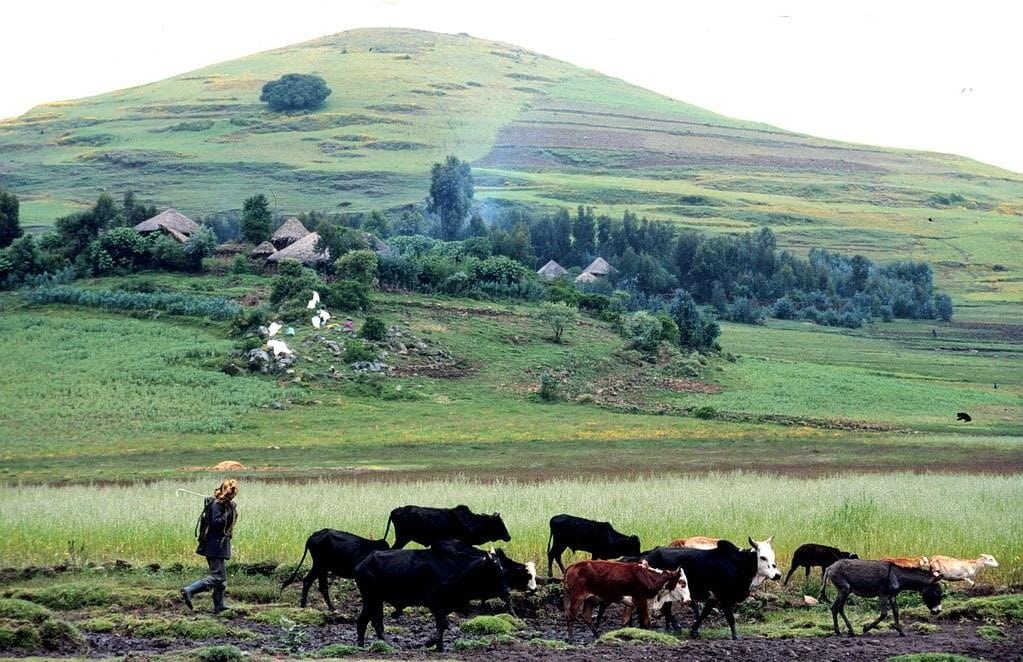Farmers face an array of threats to their crops and livelihood. Arguably the greatest threat of all is soil degradation and dessication. Nothing will grow in soil that’s too thin, too dry, and devoid of nutrients. Basic soil and water conservation practices are essential to growing vital and healthy crops year after year, especially in drier highland areas where sloping topography encourages erosion and climate change makes rain-fed agriculture increasingly precarious.
Luckily, smallholder farmers surviving in these kinds of marginal lands can rely on fairly simple technologies and methods to help them fight erosion, maintain healthy soils in their fields, and retain adequate soil water for when the rains fail to turn up as expected. But will they adopt these technologies and practices? A new study out of the highlands of Ethiopia suggests that the answer is yes, they will, but only under certain conditions.
The picture in South Wollo
Two researchers based at Wollo University in Ethiopia set out to determine whether farmers living in the neighboring highlands were aware of methods they could use to promote soil and water conservation, which ones, and whether they were practicing them. They surveyed over 300 smallholder farm families in a wide swath of southern South Wollo province, particularly in the Lege-Lafto Watershed. The team also gathered data through surveys, individual and group interviews, and focus groups they organized to gauge community awareness of the twin threats of erosion and soil degradation. The two scientists also embarked on a general visual tour of the region to determine how commonplace some traditional soil and water conservation techniques are. “The main objective of this study was to assess farmers’ adoption decisions of soil and water conservation (SWC) practices,” co-authors Gizachew Shewaye Yifru and Birhan Asmame Miheretu explained in a paper.
Soil degradation is a major concern for Ethiopia. Population growth has contributed to deforestation and pushed farming into more marginal, less productive lands. Over-cultivation and overgrazing quickly followed, even in the nation’s most productive agricultural regions. Farming is rapidly becoming untenable in much of the country.
“Land degradation in rural Ethiopia is seen as one of the key factors for low productivity and food insecurity.”
Ethiopia’s central government has been busy for decades trying to reverse the damage, mainly through outreach initiatives aimed at encouraging soil and water conservation and sustainable agricultural practices. Agriculture is critical to Ethiopia’s economy and future, so it’s important to get the word out to the millions of smallholder farmers that feed that nation. “Land degradation in rural Ethiopia is seen as one of the key factors for low productivity and food insecurity,” the research pair wrote. “Soil degradation is one of the most serious environmental problems in Ethiopia, particularly in the highlands.”
Getting the message across
Are Addis Ababa’s messaging efforts reaching highland farmers? Yifru and Miheretu discovered that they are, at least to a certain extent.
Some 64% of the farmers surveyed are practicing soil and water conservation on their farms, often simple but effective methods that can be adapted to other regions. In one such method, farmers pile up soil to create a “bund” or barrier meant to keep soils and water from migrating downslope. Some farmers use stones or even wood instead of soil in this system. Terracing and planting crops to match the contours of hillsides are common, as well. “The findings depicted that soil bund, stone bund, stone-faced soil bund, loose stone and brush-wood check dams, hillside terrace, and bund stabilized with vegetation are practiced in the watershed,” they noted. Yifru and Miheretu describe their findings in a paper just published in PLOS ONE (https://journals.plos.org/plosone/article?id=10.1371/journal.pone.0265071).
Mission accomplished? Hardly.
If their study sample is representative, then some 36% of Ethiopia’s highland smallholder farmers are not taking sufficient measures to retain soil and soil water content, meaning their future output is in jeopardy. This despite decades of outreach and assistance by the government. Yifru and Miheretu think they know why—farmers were more likely to be aware of and practice soil and water conservation measures if farming was their full-time job and if their farms were closer to markets. Longer distances mean farmers are planting crops on more marginal lands, and the initial lower productivity of these fields pushed farmers to seek other employment to earn the incomes necessary for their families to survive. Soil degradation is still worsening, but farm families in these regions don’t have the capital to build soil and water protection infrastructure, trapping them in a downward spiral.
Yifru and Miheretu say the government, nonprofits, and/or agricultural innovators must find a way to pull these smallholder farmers out of this vicious cycle. The role of Grow Further could be to support the development and testing of innovative practices that provide better alternatives for farmers that the government has tried unsuccessfully to reach for decades.
— Grow Further
Photo: A cattle rancher leads his herd past fields in Ethiopia’s highland country. Apollo Habtamu, International Livestock Research Institute.




